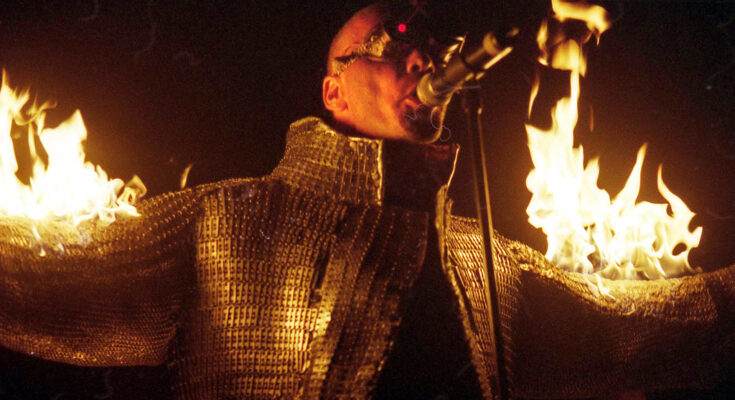“𝐃𝐚𝐧𝐠𝐞𝐫𝐨𝐮𝐬 𝐒𝐩𝐞𝐜𝐭𝐚𝐜𝐥𝐞”: 𝐑𝐚𝐦𝐦𝐬𝐭𝐞𝐢𝐧 𝐅𝐚𝐜𝐞𝐬 𝐁𝐚𝐜𝐤𝐥𝐚𝐬𝐡 𝐨𝐯𝐞𝐫 𝐀𝐜𝐜𝐮𝐬𝐚𝐭𝐢𝐨𝐧𝐬 𝐨𝐟 𝐑𝐨𝐦𝐚𝐧𝐭𝐢𝐜𝐢𝐳𝐢𝐧𝐠 𝐍𝐚𝐳𝐢 𝐈𝐦𝐚𝐠𝐞𝐫𝐲 𝐟𝐨𝐫 𝐒𝐡𝐨𝐜𝐤 𝐄𝐟𝐟𝐞𝐜𝐭.
Rammstein has always stood at the crossroads of controversy and creativity, a band unafraid to provoke, unsettle, and spark debate through their performances and visual storytelling. Yet, with their latest work drawing accusations of romanticizing Nazi imagery for shock value, the German industrial metal giants once again find themselves at the heart of an international storm. The charge against them is not new, as similar debates have surrounded the band for decades, but the renewed backlash reveals how sensitive cultural memory remains when art intersects with the darkest chapters of history. Critics argue that by weaving Nazi-style aesthetics into their videos, stage designs, or promotional material, Rammstein crosses a line from satire or critique into glamorization. Supporters, however, defend the band’s provocative choices as part of their long-standing artistic philosophy—forcing audiences to confront uncomfortable realities rather than sweeping them under the rug. This tension is what gives the controversy its sharp edge, leaving no room for neutrality in how one perceives their art.
The accusations are rooted in the belief that the band uses historical symbols not merely as a critical lens but as aesthetic tools designed to shock, sell, and generate publicity. For instance, imagery reminiscent of Leni Riefenstahl’s infamous propaganda films, with their stark lighting, rigid formations, and militaristic undertones, has repeatedly appeared in Rammstein’s creative output. Detractors see this as an unnecessary flirtation with a visual language forever tainted by its association with fascism. They argue that the band, fully aware of the power of these symbols, manipulates them to stir outrage and remain in the headlines, blurring the line between critique and exploitation. For those who lost family to the horrors of World War II or who carry the scars of fascist persecution, such artistic choices can feel less like commentary and more like a cruel aestheticization of trauma.
Rammstein’s defenders counter this criticism by emphasizing the group’s broader artistic trajectory. Since their inception in the mid-1990s, the band has been known for staging performances that explore the darker sides of human history, psychology, and politics. Fire, uniforms, rigid choreography, and theatrical dominance are all staples of their performances, and according to fans, these are tools not to glorify oppression but to hold a mirror to society’s fascinations with authoritarian power and spectacle. To them, Rammstein’s controversial use of imagery is meant to critique the ways authoritarian symbols continue to fascinate and terrify. The band’s penchant for provocation, they argue, has always been about exaggeration and parody rather than admiration. The discomfort audiences feel, far from being accidental, is intentional.
The challenge, however, lies in the ambiguous nature of art itself. What one person perceives as satire, another might interpret as celebration. In Rammstein’s case, the theatrics often walk a fine line, and critics insist that the band does little to clarify their intent. Unlike artists who explicitly frame their work with explanatory notes or disclaimers, Rammstein thrives on opacity. Their refusal to explain or apologize for their choices is part of their mystique but also part of why accusations of glamorization stick. To some, their silence on such matters speaks louder than words, suggesting an indifference to how their art might be co-opted by extremist sympathizers. This concern is particularly acute in today’s world, where symbols can be stripped from their original context and repurposed online as tools of hate.
Germany’s cultural landscape also plays a role in intensifying the backlash. The country carries the burden of historical responsibility for the atrocities of the Nazi regime, and its cultural institutions are particularly sensitive to how the past is represented. What might be tolerated as provocative art in another country can be deeply offensive within Germany’s borders, where even the display of certain symbols is tightly regulated by law. In this context, Rammstein’s repeated forays into militaristic aesthetics provoke not just artistic critique but moral outrage. To many observers, their stagecraft appears to flirt with a normalization of images that society has worked hard to keep in the shadows.
Despite this, Rammstein’s global popularity shows little sign of waning. Their concerts remain sold-out spectacles, their albums chart-topping releases, and their music videos viral events. This enduring appeal underscores a paradox: the very controversies that enrage critics often fuel the band’s cultural relevance. Rammstein thrives in controversy, their name consistently tied to debates about censorship, freedom of expression, and the limits of art. For many fans, the band’s willingness to push boundaries is precisely what makes them compelling. To sanitize their aesthetic, in their eyes, would be to betray the spirit of artistic provocation that has defined their career.
But the debate over their alleged glamorization of Nazi imagery also reflects broader cultural anxieties. In an age of rising nationalism and political polarization, the line between critique and endorsement has grown increasingly blurred. Artists who dabble in fascist aesthetics risk being misinterpreted or, worse, appropriated by extremist movements eager for cultural validation. Critics worry that even if Rammstein’s intent is satirical, their lack of explicit denunciation creates a vacuum in which dangerous interpretations can flourish. The shock value that once felt edgy in the 1990s may now carry heavier consequences in today’s volatile cultural climate.
At the same time, it is important to recognize that Rammstein has, on numerous occasions, used their platform to challenge authoritarianism and intolerance. Their lyrics, while often abstract, touch on themes of violence, repression, and the dehumanizing effects of power. Their music videos frequently expose hypocrisy and excess, portraying dystopian worlds that critique rather than endorse domination. Yet the band’s visual language is so steeped in ambiguity that these critical undertones are often lost amidst the flames and the uniformed aesthetics. To an untrained eye, the spectacle can appear dangerously close to celebration.
This tension between intention and perception lies at the core of the ongoing backlash. Rammstein’s refusal to simplify their art or provide easy answers forces audiences into a state of unease. For some, that unease sparks reflection about the seductive power of fascist aesthetics; for others, it feels like exploitation of historical wounds for entertainment. The controversy, then, is not just about Rammstein but about how societies grapple with their past, how art should handle collective trauma, and where the line between provocation and irresponsibility should be drawn.
As the debate rages on, Rammstein continues to stand firm in their silence, neither confirming nor denying the accusations of romanticization. This very silence fuels their enigmatic aura, ensuring that their name remains a lightning rod for cultural conflict. Whether one sees them as provocateurs with a critical message or performers exploiting taboo for fame, the fact remains that Rammstein has succeeded in making art that demands a reaction. Love them or loathe them, they force a confrontation with history’s shadows—a confrontation that is as uncomfortable as it is necessary.
In the end, the question may not be whether Rammstein glamorizes Nazi imagery but whether society is prepared to wrestle with the reasons such imagery continues to fascinate. Their art, deliberately or not, highlights the enduring power of symbols that should have long lost their allure. And while critics may rightly challenge the ethics of such provocations, there is no denying that the band’s work keeps the conversation alive. That conversation, as divisive as it may be, is perhaps the very essence of what Rammstein seeks to ignite: a fire that forces us to examine the past, the present, and our own discomfort with both.



